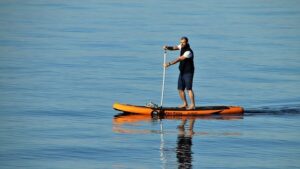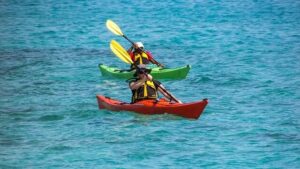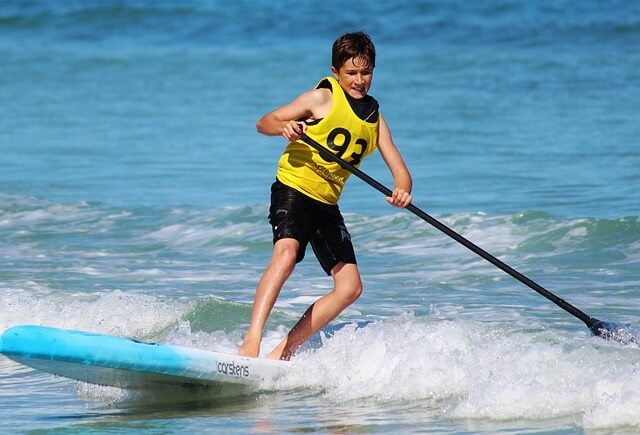Stand-up paddleboarding, or SUP, is an activity that has seen a surge in popularity in recent years. This is not surprising as SUP is an accessible and enjoyable water sport that can be enjoyed in a variety of different waters – from the ocean to rivers and lakes.
Because SUP originated in Hawaiian culture, it is often seen as a type of surfing and, in many ways, the two activities share many similarities.
In this blog post, we’ll be taking a look at the growing popularity of SUP and its relationship with surfing, exploring the differences and similarities between the two.
We’ll also explore the various types of SUP boards and discuss why SUP is such a popular recreational activity.
By the end of this post, readers should have a better understanding of SUP and its connection with surfing.
SUP and its origins
The origins of SUP can be traced back to ancient Polynesia, where the sport was used as a mode of transportation and fishing.
However, the modern version of the sport has its roots in the 1960s in Hawaii, where surfers began to stand on their boards and use paddles as a way to improve their wave-riding skills.
In the early 2000s, the sport began to gain popularity on the mainland United States and has since spread to other parts of the world. SUP has become increasingly popular due to its accessibility.
Unlike traditional surfing, which requires waves to ride, stand-up paddleboarding can be done on both flat and choppy water, making it accessible to people of all skill levels regardless of where they live.
Additionally, the sport is low-impact, enabling people to get a great workout without putting too much strain on their joints. All you need is a board, a paddle, and a body of water and you are ready to go!
Over the years, stand-up paddleboarding has become an increasingly popular way of exploring the outdoors, staying active, and appreciating nature.
With the emergence of various styles of the sport, such as racing, yoga, fishing, touring, and even river surfing, stand-up paddleboarding has established itself as a dynamic and exciting way to enjoy the great outdoors.
To accommodate the growing number of stand-up paddleboarders, specialized equipment such as boards and paddles have been developed, making it even easier to get involved.
Today, stand-up paddleboarding has created a thriving community of passionate and dedicated enthusiasts and continues to increase in popularity.
The SUP experience
The SUP experience is a unique one that is gaining traction in the surfing world. It’s becoming increasingly popular due to the fact that it offers an enjoyable way to experience the ocean like never before.
It is incredibly versatile and can be used in a variety of ways, from calm, flat-water paddling to surfing small waves.
You’re also able to explore new areas and get up close and personal with the ocean’s inhabitants in ways that are not possible with surfing.
The SUP experience is one that is quickly becoming a favorite amongst surfers and non-surfers alike.
Stand-up paddleboarding (SUP) offers a unique and immersive experience on the water. The sensation of being on a board and using a paddle to move through the water is both exhilarating and calming.

The sport allows for a close-up view of the natural surroundings, whether it’s the ocean, a lake, or a river. The gentle paddling motion can be meditative, helping to clear the mind and ease stress.
The activity can be enjoyed alone or with friends and family, making it a great way to bond and make memories.
Paddleboarding can also be a great workout, as it engages the core, legs and arms muscles. It can also improve balance and coordination.
The sport is also versatile, as there are different types of boards and paddles that cater to different skill levels and preferences, as well as different types of water conditions.
Furthermore, stand-up paddleboarding can also be a way to discover new places and hidden gems on the water.
It can be an opportunity to explore coastlines, rivers and lakes that may be inaccessible by other means. It can also offer a different perspective on familiar places, making it a unique and exciting way to discover the natural world.
Overall, the stand-up paddleboarding experience is a combination of adventure, fitness and relaxation that can be enjoyed by people of all ages and skill levels.
SUP and surfing similarities
Stand-up paddleboarding (SUP) and surfing may have similarities, such as standing on a board and navigating through the waves, but SUP has become increasingly popular due to its flexibility, allowing for both leisurely flat-water paddling and tackling challenging surf.
The two sports also share the same basic equipment – a board, paddle, and wetsuit. The core principles of balance, strength, agility, and control are shared between both SUP and surfing, but the major difference lies in the use of a paddle with SUP.
This provides increased mobility and a greater range of motion, allowing for enhanced control and precision. For those looking to get more involved in watersports, SUP and surfing can be a great combination, allowing for further exploration and a heightened appreciation for different watersports.
SUP compared to other water sports
SUP compared to other water sports is one of the main reasons that it has seen such a rapid increase in popularity in recent years. SUP is easier to learn than traditional surfing, requires less equipment, and is more social than other water sports .
It’s also relatively safe, since it’s practiced in shallow water, and has a low barrier to entry. It’s easy to see why SUP is becoming a preferred activity for many people looking to get out on the water.
Stand-up paddleboarding (SUP) is a unique water sport that offers a different experience compared to other water sports such as surfing, kayaking, and canoeing.

One of the main differences between SUP and these other sports is that it allows for a standing position on the board, which provides a better view of the surroundings and a different perspective on the water.
This standing position also allows for a greater range of motion, which makes it possible to perform different maneuvers and tricks.
In terms of accessibility, stand-up paddleboarding is more versatile than surfing, as it can be done on both flat and choppy water, whereas surfing requires waves to ride.
Additionally, stand-up paddleboarding is considered a low-impact sport, making it a great option for people looking for a workout that is easy on their joints. This is different than surfing, windsurfing or kitesurfing which are considered high-impact sports.
When compared to kayaking and canoeing, stand-up paddleboarding offers a more dynamic and physically demanding experience.
The standing position and use of a paddle require greater balance, core strength, and upper body strength. It also allows for more maneuverability and speed on the water.
In terms of equipment, stand-up paddleboarding is relatively simple, as it only requires a board and a paddle. This is different than other water sports such as windsurfing and kitesurfing, which require specialized equipment such as sails and kites.
The sport’s growing popularity
Stand-Up Paddleboarding (SUP) has taken the world by storm in recent years. Its accessibility, ease of learning, and range of environment possibilities make it the perfect sport for people of all ages, from children to seniors.
This incredible sport is projected to reach an astounding global market of $4 billion by 2026, adding big momentum to the already booming surfing industry.
With SUP acting as a great entry point for many surfers to explore the ocean, the two activities have a great symbiotic relationship.
Whether it’s for exploring lakes, braving choppy oceans, or just having an incredible time, SUP is the perfect way to experience the world in a whole new way.
The importance of safety when paddleboarding
Stand-up paddleboarding (SUP) is becoming more and more popular every day – and it’s easy to see why! SUP offers an exciting way to explore the water while still allowing you to work on your balance and core strength.
But it’s important to remember that safety is always essential when paddleboarding, regardless of your experience level.
Make sure you know the waters you’re paddling in, wear an appropriate life jacket, and be aware of other paddlers and boat traffic.
Additionally, be sure to check the weather before you paddle, so you’re prepared for any changes in conditions. Taking these safety measures will help ensure that your SUP experience is both enjoyable and safe.
The benefits of paddleboarding
One of the biggest benefits of paddleboarding is that it is easy to learn. Even if you have never been on a surfboard before, you can learn the basics of paddling in a matter of hours.
Stand-up paddleboarding (SUP) is an excellent way to get a full-body workout while gaining the physical and mental benefits of being on the water.
Physically, SUP engages the core, legs, and arms muscles, while also improving balance and coordination. The low-impact nature of the sport makes it a great option for people looking for a workout that is easy on their joints.
Mentally, SUP can be incredibly meditative, helping to clear the mind and ease stress. The gentle paddling motion and beautiful natural surroundings can create a sense of calm and tranquility, while offering a chance to disconnect from technology and daily distractions.
Not only does stand-up paddleboarding offer physical and mental benefits, but it can also be a great way to explore and discover new places. Whether it’s the ocean, a lake, or a river, SUP gives you the chance to enjoy the beauty of nature and to make memories with friends and family.
Stand-up paddleboarding is a great way to stay active, explore the outdoors, and make lasting memories with friends and family.
It’s a fun, low-impact water sport that can be enjoyed by people of all ages and skill levels.
Furthermore, it also has numerous health benefits, such as improving cardiovascular health, increasing muscle strength and endurance, and aiding in weight loss.
It even has the potential to be used as a form of physical therapy for injuries and illnesses.
Lastly, paddleboarding is an affordable and accessible activity. The equipment is relatively cheap and easy to transport, and you don’t need a lot of space to store it.
Types of SUP boards available
Stand-up paddleboarding (SUP) has grown in popularity in the last few years, and with it, the variety of SUP boards available has expanded.
There are many types of SUP boards to choose from, each with its own unique characteristics. The type of SUP board you choose will depend on your skill level, the type of water you plan to paddle on, and your preferences.
Stand-up paddleboards (SUP) come in a variety of shapes and sizes to suit different types of water conditions and paddling styles. The most common types of boards are:
- All-around boards: These are the most versatile boards and are suitable for a wide range of conditions and skill levels. They are designed for flat water, small waves, and recreational paddling. They are generally longer and wider than other types of boards, making them more stable and easier to balance on.
- Touring boards: These boards are designed for longer distance paddling, such as on lakes, rivers, and the ocean. They are generally longer and narrower than all-around boards, which makes them faster and more efficient, but less stable. They also often have additional features such as a built-in rudder or skeg for better tracking and maneuverability.
- Surf boards: These boards are designed for riding waves and are generally shorter and wider than all-around or touring boards. They are more maneuverable and are designed for quick turns and riding smaller waves. They are also less stable than all-around boards, and therefore, recommended for more experienced paddlers.
- Inflatable boards: These boards are made of durable PVC material and can be deflated and packed into a bag for easy transportation. They are a great option for people who do not have a lot of storage space or who travel frequently. They are also very durable and can be used in a variety of water conditions.
- Yoga boards: These boards are designed specifically for yoga and fitness, with a wider and more stable platform for better balance and stability. They often have a non-slip surface and tie-down points for accessories like anchors.
When choosing a board, it’s important to consider the type of water conditions you will be paddling in, your skill level, and your intended use (recreational, racing, yoga, etc.).
An all-around board is a great option for beginners, while more experienced paddlers may prefer a touring or surf board.
Inflatable boards are a great option for people who travel frequently or have limited storage space. Yoga boards are a great option for those interested in practicing yoga on water.
Conclusion
Stand-up paddleboarding (SUP) has become an increasingly popular water sport, especially among surfers.
SUP actually grew out of surfing and shares many of surfings techniques, such as paddling and wave-riding. SUP has some of the same benefits as surfing, such as a great workout, relaxation and the beauty of being out on the water.
It also provides a unique perspective that can only be experienced from a SUP board. Whether you’re a surfer looking to try something new or a beginner looking to give water sports a try, stand-up paddleboarding is an excellent choice.
Shop Surf Jewelry
Finding the ideal Surf Jewelry to match your Surfer look can be challenging and time-consuming, especially if you lack inspiration or don’t know where to look.
Surflegacy has you covered. We have a wide range of surf-style necklaces and bracelets, to accentuate your surfer look.
Our pieces are crafted in Italy with care and style in mind, reasonably priced, so you won’t have to break the bank to get one. Visit our store and let us assist you on your fashion journey






